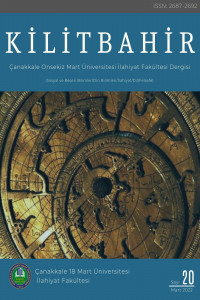Öz
Nahivcilerin Arap dili ile alakalı bir kaideyi tespit ederken başvurdukları referansların başında eski Arap şiiri gelmektedir. Bazı beyitlerde tespit edilen kurallara aykırı kullanımların olduğu da bir gerçektir. Bu da nahivcilerin şiirin kendine has özelliği hakkında farklı değerlendirmelerde bulunmalarına yol açmıştır. Nitekim kimileri vezin, kâfiye, ahenk ve şiir nağmesi gibi etkenlerden ötürü bu tür kullanımların şairler için bir zorunluluk olduğunu söylerken; bazı nahivciler bu kullanımların Arap dili ve lehçelerine uygun olduğunu öne sürmüşlerdir. Nahiv ve sarf kaidelerine uymayan şâz bir kelime, her ne kadar kural dışı olarak ele alınmışsa da nahivciler tarafından değersiz görülüp bir tarafa itilmemiştir. Bilakis üzerinde kafa yorulmuş, nahvin ve sarf ilminin temel kaidelerine uyup uymama hususunda çeşitli kısımlara bölünmüş ve bazı kısımlar nahvin anlaşılmasında önemli görülmüştür. Eski Arap şiirinde dil kurallarına aykırılık arz eden kullanımlar, şiirin kendine özgü durumunu göstermektedir. Kuraldışı görülen bu kullanımlar zarûret olgusu altında ele alınmıştır. Dil kurallarının oluşum sürecinden itibaren zarûret olgusu nahivci, edebiyatçı ve eleştirmenlerin dikkatini çekmiş ve muteber kabul edilen birçok klasik eserde doğrudan ve dolaylı bir şekilde yer almıştır. Şiirin tabiatına bakıldığında nesirde olmayan vezin ve kafiye gibi bazı zorunluluklar şairi zarûrete başvurmaya mecbur bırakır. Zarûretler de kendi içerisinde birkaç yönden taksime tabi tutulmuştur. Morfolojik zarûretleri ele alacak olan bu çalışmada nahivcilerin bu kullanımlara yönelik yaklaşımları eleştirel bir metotla incelenmeye çalışılacaktır.
Anahtar Kelimeler
Kaynakça
- Abdullatîf, Muhammed Hamâse. Luġatu’ş-şi‘r: Dirâse fi’ḍ-ḍarûreti’ş-şi‘riyye. Kahire: Dâru’ş-Şurûk, 1996. Absî, ‘Antere b. Şeddâd. Dîvânu ‘Antere. thk. Muhammed Se‘îd Mevlevî. Kahire: el-Mektebu’l-İslâmî, 1964. Âlûsî, Mahmûd Şukrî. eḍ-Ḍarâ’ir ve mâ yesûġu li’ş-şâ‘ir dûne’n-nâs̱ir. Bağdâd: el-Mektebetu’l-‘Arabiyye, 1922.
Öz
Ancient Arabic poetry is one of the references that language scholars apply to when determining a rule related to the Arabic language. It is also a fact that there are uses that are contrary to the rules established in some verses. This has led to different assessments of the idiosyncrasy of poetry by language scholars. As a matter of fact, some people say that such uses are a necessity for poets due to factors such as vezin, rhyme, harmony and poetry tune; some language polished have suggested that these uses are appropriate for Arabic language and dialects. a word that does not comply with the syntactic and morphological pedestals, although it is considered illegal, is considered worthless by linguists and is not pushed to one side. On the contrary, we have been thinking about it, it has been divided into several parts regarding whether it conforms to the basic principles of syntax and morphological science, and some parts have been considered important in understanding the science of syntax. The uses that contradict the rules of language in ancient Arabic poetry show the peculiar situation of the poem. These uses, which are considered to be illegal, are considered under the phenomenon of necessity. Since the process of formation of the rules of language, the phenomenon of necessity has attracted the attention of nahivists, literati and critics and has been directly and indirectly included in many classical works that are considered muteber. Considering the nature of poetry, some imperatives that are not in prose, such as vezin and rhyme, oblige the poet to resort to necessity. Necessities have been taxied in several ways within themselves. In this study, which will address morphological necessities, the approaches of nahivists to these uses will be examined with a critical method
Anahtar Kelimeler
Arabic language Morphological Poetry Syntax scientists Necessity
Kaynakça
- Abdullatîf, Muhammed Hamâse. Luġatu’ş-şi‘r: Dirâse fi’ḍ-ḍarûreti’ş-şi‘riyye. Kahire: Dâru’ş-Şurûk, 1996. Absî, ‘Antere b. Şeddâd. Dîvânu ‘Antere. thk. Muhammed Se‘îd Mevlevî. Kahire: el-Mektebu’l-İslâmî, 1964. Âlûsî, Mahmûd Şukrî. eḍ-Ḍarâ’ir ve mâ yesûġu li’ş-şâ‘ir dûne’n-nâs̱ir. Bağdâd: el-Mektebetu’l-‘Arabiyye, 1922.
Ayrıntılar
| Birincil Dil | Türkçe |
|---|---|
| Konular | Dil Çalışmaları |
| Bölüm | Araştırma Makaleleri |
| Yazarlar | |
| Yayımlanma Tarihi | 18 Mart 2022 |
| Gönderilme Tarihi | 10 Aralık 2021 |
| Yayımlandığı Sayı | Yıl 2022 Sayı: 20 |
Çanakkale Onsekiz Mart Üniversitesi İlahiyat Fakültesi Dergisi olarak yayınlanan dergimiz 1 Ağustos 2019 tarihi itibari ile adını Kilitbahir olarak değiştirmiştir.

This work is licensed under a Creative Commons Attribution-NonCommercial 4.0 International License.

